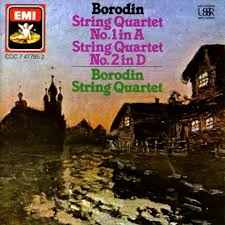String Quartet No. 1 in A Major (1879)
Alexander Borodin
Borodin Quartet (1980)
reviewed by Tom-Tom
Alexander Borodin was not, chiefly speaking, a composer. He was a chemistry professor at the Medical Surgical Academy in St. Petersburg. Composing was for him a special love which he tenderly nurtured on his few days off or sick days along with professing women’s rights. I imagine him whistling some tune of his while grading papers or conducting his famous chemical reaction experiments. A dyed in the wool Romantic composer, his melodies are almost all very lovely and memorable although natural and original. He composed a small but significant body of work from chamber works (leaving a few unfinished) to an unfinished opera he spent 18 years on. Without the concert season deadline stress of day job composers, he could tinker with his compositions until they met his satisfaction.
This well cared for aspect is very present in his two famous string quartets in A and D major. Written in the last 10 years of his life, they are pleasant, thoroughly composed works of interwoven melodies and tight knit harmony. Who knows how many semesters these golden melodies were floating around in Professor Borodin’s head.
The first movement of String Quartet no. 1 opens with a light and free melody involving all the instruments one by one with the First Violin leading a starry sky like serenity. The Viola and Second Violin share the reprise but add tension to let the First take the melody to stormy clouds. The cello remains in a half and whole note capacity. The tempo picks up with a Mendelssohn Scottish Symphony sort of conversion. The three upper strings dominate most of the movement going in all directions with the opening and tempo change melody. It is neither sonata form or the typical theme and variations style. Yes, the same melody comes and goes but rather than annoying the listener, it is interesting to see how it evolves and what new melodies join it. It takes on the shape of a fugue here and counterpoint there but it doesn’t fall into any predictable formula. Borodin has a melody share and he’s excited about it. We feel that excitement and it is easy to relax and let the excitement pass over us. There is something of the excitement of Mendelssohn’s younger string works but with more mature use of all instruments with emphasis on the violins. His use of fugue and counterpoint are both natural. He’s not trying to give just a one off salon virtuoso performance. The piece ends with starry sky serene harmonics by almost all.
The second movement begins with just the upper strings in harmony smoothly playing a melancholy melody. The other instruments join reprising it. The real fire turns on with a arpeggio cry over a quartet power chord. It is quickly softened as the melody evolves into a wandering theme passed around the ensemble tiptoeing frequently between major and minor melodies rather moodily. A fugue-like buzzing begins with a cue from the cello and the harmonies which evolve to cover the tunes become themselves melodies. It’s fun to follow. The arpeggio cry returns and with it the initial melody so sadly sweet. These two take turns until the movement resolves with the heartbeat like rhythm of the playing the beat.
The Scherzo third movement explodes with triplets a plenty by the violins with random pizzicato announcing the end of musical phrases. This gives way to the Trio’s serene winter’s night of harmonics by all which is smoothly crystalline until all burst reprising the melody but with full on vibrato. The Scherzo returns and all share the frenetic melody save for the cello who keeps the beat with bowed or pizzicato strokes.
The fourth and final movement opens with a dramatic Andante sounding rather fed up but echoing (again using harmonic)s in places feeling as if calling from a mountain top. After a couple angry chords, a furious melody in six starts to heat up and explodes with sextuplets before regrouping into yet another fugue. The piece tiptoes again between reassurance and aggression before easing into a cushy syncopated melody which bounces around the ensemble and then combines earlier melodies into some counterpoint before reprising the initialfurious melody. This is probably the most structurally speaking stable movement aside from clean cut Scherzo and Trio of the third movement. The rhythms of the two competing melodies coalesce into an enjoyable coda which rises higher and higher until a few broad chords shared by the ensemble bring everyone to rest on the initial chords that began the Quartet’s first movement.
Borodin’s reliance on wandering melodies that come around full circle after playing around with fugues and counterpoint but not exhaustingly finds just the right balance. This Quartet is a great success and demands a great many listens. As the composer himself never tired of it during the 5 years he took to compose it, neither do we.
Tom-Tom

